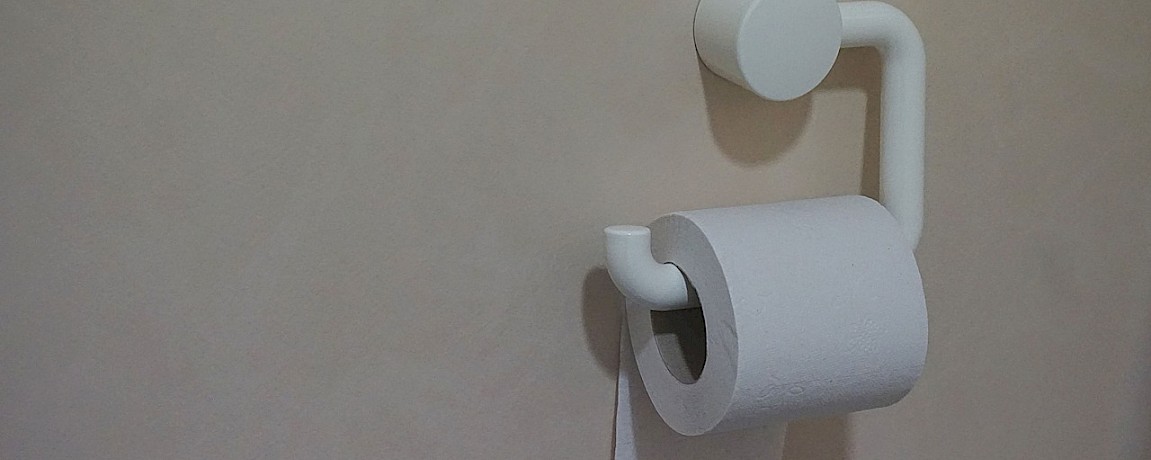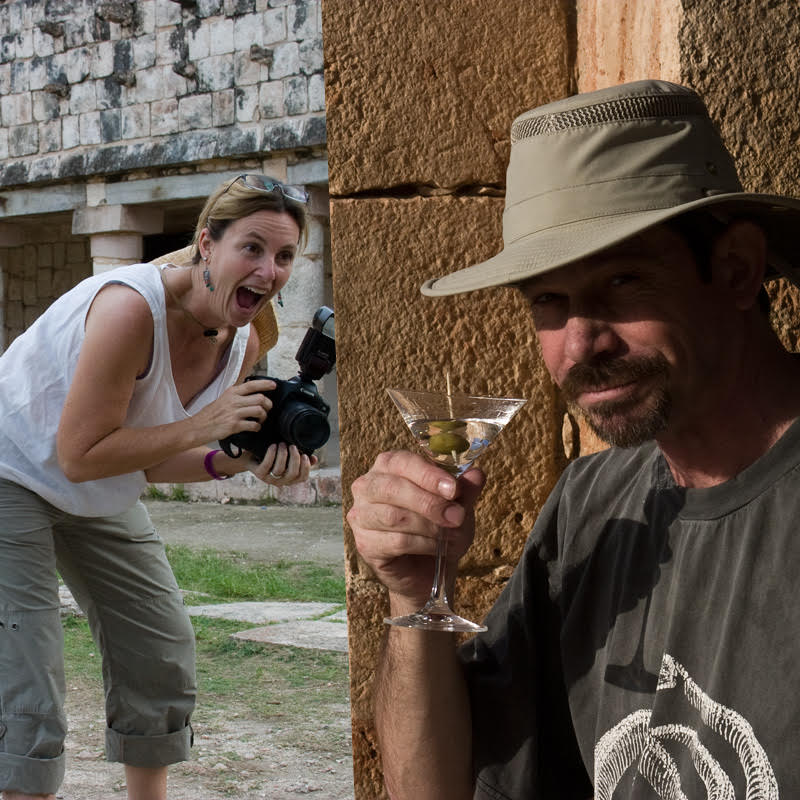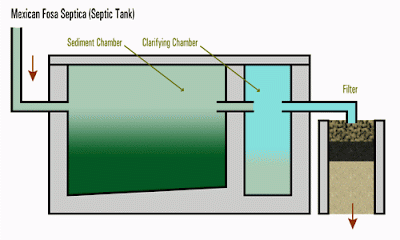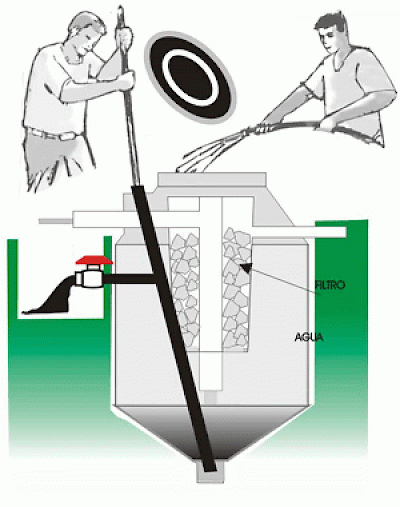Mexican Septic Systems
We promised to explain why you should not put paper in a Mexican toilet, and we’re not going to let you down. There are actually several answers to this question and the most puzzling of these is: you can put paper in a Mexican toilet! Yes, you can. The toilet will not spit the paper back out like a wrinkled dollar from a vending machine. The toilet police won’t show up at your door. And there will be no immediate ill effect from your indiscretion.
But it would be rude.
In many tourist destinations in Mexico, especially hotels, where modern sewage treatment is available, you are encouraged to flush your paper, just like in Gringolandia. The hotel management may even post little signs to let their Mexican guests know that they are expected to dispose of their papel confort down the toilet. They have to do this because Mexicans are trained from birth to be very polite.
But away from the tourist hangouts, and especially in private homes, you will encounter a small, covered, plastic or plastic-lined wastebasket near the toilet. If you see one, then be a polite guest and put your paper in there, not down the toilet.
To understand what etiquette has to do with how you dispose of toilet paper in Mexico, we need a basic understanding of sewer systems. If you are reading this from your home or office in Gringolandia, chances are that your toilet (and anything else that drains from your house) is connected to your city’s public sewer system. Everything you flush flows through large concrete pipes to an industrial processing plant where the solids are separated from the liquids. The liquids are filtered and treated with chemicals and the result is released back into the environment in the least offensive way possible where nature finishes the process using evaporation and rain. The solids are also treated and refined, resulting either in trash or fertilizer. This immense infrastructure is quite expensive to install, operate and maintain. It also consumes a lot of energy. These are your tax dollars at work.
Gringos who flush outside the city limits use a private septic tank, called a fosa septica (septic pit) or sumidero (drain) here in Mexico. In Gringolandia, a septic tank is usually made of a durable plastic and has two chambers, each with a pipe tee inside. The first is the sediment chamber, where the wastewater initially enters. User Plawerth explains the process neatly in his comment:
When waste enters the tank, the paper, poo, and any oils from bathing will float near the surface as a layer known as scum. Over time bacteria will consume nutrients in the scum, and it then settles on the bottom as dense sludge, which is basically inert compost.
When liquid enters the tank, an equal amount of liquid flows out the drain pipe. The tee with its long tube extending down below the surface prevents the floating scum from leaving the tank. The upper part of the tee allows methane and other gases to vent out, while preventing soap foam and lightweight scum above the water line from leaving the tank.
Some scum can still potentially pass, though, which is why there is almost always at least two chambers, and sometimes three chambers, each with a tee on the liquid outlet to restrict scum from leaving the chamber. Usually the first chamber contains most of the sludge and the second and third chambers contain little or no sludge.
If the tank is not cleaned of sludge often enough, eventually it will fill with sludge in all chambers, and then solids will start to leave the tank and plug up the leach field.
A filter on the final outlet will help keep solids that are overflowing out from a poorly maintained septic tank from reaching the drain field, but this needs to be a fine mesh plastic screen or a layer of sand, not just a pile of large loose rocks.
Unlike their northern neighbors, almost all Mexicans use a fosa septica, which is not much different than a Gringolandia septic tank. This technology is very old, so the process is the same. The only difference is the materials. Here in Mexico, many of the colonial houses and other buildings were constructed before the advent of plastics, so most fosa septica are built from plastered stone or concrete block. While plastic septic tanks have one or more manhole covers to permit inspection and cleaning, Mexican fosa septica are generally covered with a slab of concrete and sealed with plaster, like a tomb.
The important difference between a traditional, Mexican fosa septica and a plastic, Gringolandia septic tank is what happens when the clarified liquid is released back into the environment. In the plastic version, the liquid enters one or more perforated PVC pipes, which are buried in long trenches about four feet deep, filled halfway with gravel and covered with topsoil. This is called a drain field, and it’s where you want to plant your strawberries.
In the traditional, Mexican version, the liquid flows down into a filtro (filter), which is a concrete-lined pozo (well) filled with several inches of gravel on top, followed by several inches of charcoal in the middle, followed by a foot or two of sand at the bottom. Why use a filtro and not a drain field? One reason is because the filtro does not use plastics. Another is that this method takes up less space, which is a requirement in colonial urban zones.
But the filtro is the hurdle, so to speak, on the toilet paper trail. Even if much of the paper discarded in a Mexican toilet remains in the fosa septica’s sediment chamber, tiny bits do float past the clarifying chamber and into the filtro, so that over time a paper mache sludge builds up.
How much time does it take to clog a filtro? Nobody knows. It depends on how big the fosa septica and filtro are, how many people are using the toiliet and how much paper or other non-biodegradable stuff they’re flushing down there. It could take three years, or five, or ten. If you don’t flush any paper, it could take fifty or more.
As you probably know, all septic tank systems eventually fill up with sludge and non-biodegradable stuff and have to be pumped out. In Gringolandia, where most septic tanks are located under a lawn in the yard, this is not such a big deal: just dig for a few minutes, screw off the lid and pump away.
In Mexico, maintenance can be a bit more trouble. Many fosa septica are located under the patio, or they might be under the foundation of your house or even partially under your neighbor’s house, because many of these old colonial homes are the result of subdividing a larger mansion. Even when located in a back yard, the access is limited, which means the workers and their hoses will probably be coming through your front door. What’s more, most fosa septica are as old as the houses. Digging into them, like unearthing an ancient tomb, can be risky, leading to cracks or a complete collapse.
This is where famous Mexican thriftiness meets Mexican toilet training. No matter what their socio-economic station in life, Mexicans stretch their pesos and pretty much everything else. When the convenience of flushing paper down the toilet is at the expense of flushing pesos by cracking open a fosa septica, Mexicans would rather have the pesos. In this sense, it would be as rude to flush paper down your host’s toilet in Mexico as it would be to leave the door open on their refrigerator.
Most new homes and residential developments being built in Mexico today do use plastic septic tanks in their construction. When we were working on the design of our new home, we were offered the choice of a plastic septic tank or the traditional fosa septica. The plastic version, called a Septi-K, is billed as an environment-friendly version. It costs less than a fosa septica and has a cover you can remove to rinse the internal filter. The clarified liquids empty into a leach field or French drain. Every ten to 30 months, depending on use, you have to manually remove the lodo (uh... mud), which you can put in your yard as fertilizer or perhaps share with friends. And you can flush paper into it like a gringo.
Hmmm…
When we visit Gringolandia, we now feel uncomfortable putting paper in the toilet. Is it because sorting recyclables by hand is planet-friendly? Is it because it feels like throwing money down the toilet? Or is it just force of habit? Hard to say. In the end, we chose the traditional fosa septica for our new house.
So now you know what to do when you visit our bathroom and why you are doing it. Thanks to you, we may never have to service our fosa septica. At least in this one small way, we have assimilated into Mexican culture.










Comments
the_working_grillos 6 years ago
Thank you! We have updated the article with your comment.
Reply
Lori 7 years ago
Hello,
I live in Chuburna de Higaldo and have never had a septic system. I moved here a year and a half ago and told the owner I spelled sewage coming out of my bathroom sink and shower on a continuous basis. She blamed it on something else and had a plumber change the position of the plastic tube under the kitchen sink with a clothes hanger wire.
Things finally got bad and something that smelled like sewage and looked like a mix of sewage, food, paper, and trash of various colors backed up into my kitchen sink and shower. She sent out guys with caustic acid powder. They mixed it with water and it got very hot and the smell was terrible. They dumped it into the shower and said to rinse it with water in the morning.
An hour later a truck came, saying the owner sent her with some sort of pressure system. They filled a large barrel with my water which is expensive and put some sort of thing in my toilet and flushed everything with pressure caused by this barrel of water. My house was left a smelly and dirty mess.
I asked if perhaps the septic tank needed to be emptied and she said she did not know where it was and it was not necessary here. She sent out two guys I had to pay $200 pesos to and they took a large pick and made two large holes in my patio looking for the pipes leading to the poso or whatever it's called. The holes are still there. Now she wants $2,000 pesos for pressure treatment saying I should have never let them in when they told me they were here because the owner sent them and she was going to pay. I guess she called the guy to put the acid in second and forgot to cancel the pressure treatment and blames it on me for not calling he to overlook the process. I had an out of town guest here and it was terrible. Now she is making my life a living hell over that money and when I told her not to send the guys to patch the holes with cement because I was sick and working from home to please send on another day she said let us in or get out of my house. I have no contract with her and just assumed large household repairs would be paid by the owner. Since moving in many things have broken and she always makes me pay half or all of it. I am very confused. Any advice would be appreciated.
Regards,
Lori
Reply
Plawerth 7 years ago
Eh, it's amazing how much is wrong here. The main part of a septic tank of any kind that keeps toilet paper out of the liquid drain, is a pipe tee on the outlet.
The bottom of the tee has a tube extension about 0.5m long extending down into the liquid, and another tube extension on the upper part that extends almost to the roof of the tank. The old style plaster/concrete tank can also be equipped with a tee on the liquid outlet.
When waste enters the tank, the paper, poo, and any oils from bathing will float near the surface as a layer known as scum. Over time bacteria will consume nutrients in the scum, and it then settles on the bottom as dense sludge, which is basically inert compost.
When liquid enters the tank, an equal amount of liquid flows out the drain pipe. The tee with its long tube extending down below the surface prevents the floating scum from leaving the tank. The upper part of the tee allows methane and other gases to vent out, while preventing soap foam and lightweight scum above the water line from leaving the tank.
Some scum can still potentially pass, though, which is why there is almost always at least two chambers, and sometimes three chambers, each with a tee on the liquid outlet to restrict scum from leaving the chamber. Usually the first chamber contains most of the sludge and the second and third chambers contain little or no sludge.
If the tank is not cleaned of sludge often enough, eventually it will fill with sludge in all chambers, and then solids will start to leave the tank and plug up the leach field.
A filter on the final outlet will help keep solids that are overflowing out from a poorly maintained septic tank from reaching the drain field, but this needs to be a fine mesh plastic screen or a layer of sand, not just a pile of large loose rocks.
Reply
W. Carter 10 years ago
In rural coastal areas, are septic tanks used to gather and hold excrement? Are septic tanks flushed out periodically?
Reply
daryl 10 years ago
Up here in victoria, british columbia the city still pumps a million gallons per day of raw sewage into the pretty harbour. Mexico has septic pits as in rural parts of canada and somehow mexico is the dirty rat ????? Kelowna discharges and has the water intake close to this and beaches get closed due to e-coli as well.
Reply
Ann 12 years ago
I went to Mexico for the first time in my life and was shocked to know that the place I was staying at, which was not a big resort, did not allow us to flush the toilet paper down the toilet. Many times I had to 'fish' out the toilet paper from the toilet because I have been accustomed to flushing my toilet paper down the toilet. I now understand why people have always said that a person should only drink bottled water...if the waste water is not filtered properly and the water is not purified, it's no wonder a person would get sick. I wish that I had read this article before going to Mexico because it was a 'rude awakening' for me. I now have a greater appreciation for my own country because I used to take things like that for granted...now I appreciate our sewage and water systems and realize how fortunate I am to live in a country that has proper sewage and water systems.
Reply
Alex 12 years ago
We live in the Sonoran desert in San Carlos . All the fosas here are basically a 10' x8' x 7' deep hole in the ground. The bottom is dirt and the sides are staggered bricks to allow effluent to bleed off. There is no drain field just the hole in the ground. These work well here but need to be flushed and pumped every 15-20 years. We do not throw toilet paper in the toilet. I like the simplicity but feel that these may be too simplistic. Would like any comments and or suggestions
Reply
wpcoe 12 years ago
I've lived in Thailand for 13 years, and for the most part, local Thais (especially in rural Thailand) do not flush toilet paper down the commode.
However, most toilets have a hand held water sprayer hanging on the wall where most of us have toilet paper rolls hanging. It is identical to the vegetable sprayers many US kitchens have at the sink. All it takes is a T-junction to be able to divert the water from the pipe in the wall to two directions: one to the commode and one to the sprayer.
Took me a few uses to master the art of spraying my backside without unduly wetting the entire bathroom, but I swear by the thing now. Wiping with paper just seems unsanitary. Ditto for using your left hand and a bottle of water.
Even better are the "washlets" of Japan, which are toilet seats with a built-in bidet function. A telescoping tube comes out the correct distance and rinses the appropriate area -- a separate setting is used for women's personal hygiene. Some models have a heating element for areas (like Japan) where the water might get too cold in winter to spray at your derrière.
I still use a little toilet paper to dry myself off, but I know many (most?) people just pull up their pants/skirts and air dray naturally. Some of the fancier Japanese washlets have a fan to blow you dry with heated air.
Reply
Lindsay 7 years ago
I had the same revelatory experience in Thailand, but not until today, when a friend let me know I could buy one on Amazon, did I have the thrilling realization that my toilet paper days have come to an end. Everyone should install this. Save the environment from toilet paper, save money on toilet paper, save your septic system, and be even cleaner than you would have been. https://www.amazon.com/dp/B07121VL4D/ref=cm_sw_r_cp_awdb_t1_STc4CbKFMZ8TW
Reply
Antonio Suarez 12 years ago
Brilliant detailed explanation! I agree how we feel when having the possibility to flush when we are used to throw paper in to bags. What I have decided is to flush the first one or two papers I use, those contain 99% of shit while I throw the rest in the classic Mexican basket bag. I have a biodigestor SIRDO which is known for is environmental compromise.
Reply
Rodrigo 12 years ago
This is nonsense. I'm a Mexican, and I have lived in Mexico City all my life. I've never heard this argument for not flushing toilet paper before. It wouldn't damage the septic tanks and even if it does it's an exaggeration to say that almost all Mexicans have septic tanks under their houses. It is actually around 3/10 people and most of them living in urban areas. The rest of the country has county sewage systems. I invite you all Americans to come to Mexico and get to know our country a little better before you start talking nonsense.
Reply
(0 to 11 comments)Next »